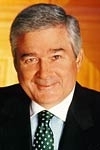CAMBRIDGE, Mass. -- Customers will acquire computing power in the future by turning on the tap, according to Louis Gerstner, chair of IBM.
"Enterprises will get computing the same way they get water and electricity now, as a service available on demand," said Gerstner, who delivered the Industry Leaders in Technology and Management lecture to an overflow crowd in Wong Auditorium Oct.10.
The new era will need self-managed systems, secure large-scale computing grids, and a massive restructuring of the information technology (IT) industry and how it delivers product to the market, Gerstner said.
Three factors are forcing change in the IT industry, he said. Computing has become ubiquitous, pushing more and more data faster and faster. Threats to data security are escalating. Finally, the accelerating complexity of computing tasks is challenging current infrastructures.
Keeping the complexity out of sight so users can focus on their businesses has already spawned a sub-industry: integration consulting. Today, 40 percent of IT spending is devoted to integrating technologies to help organizations manage multiple software programs. "Nearly half of IT expense is not adding value," Gerstner said.
Gerstner, who held leadership roles at RJR Nabisco, American Express and McKinsey & Co. before coming into the information industry, still finds the human interface of computing astonishingly poor. Would it be acceptable in the automobile industry, he wondered, to have to turn a car on and off in the middle of traffic to make it work? What other industry requires customers to press the start key to turn off their products? Computers are not user-friendly--even to the head of IBM.
Changes in human interface and new infrastructures are required to meet the future needs of customers, Gerstner said in his talk, which was co-sponsored by the Industrial Liaison Program and the Center for Technology, Policy and Industrial Development. New systems should be able to respond to the human autonomous nervous system, defend themselves against viruses, repair their own problems and reconfigure themselves to tap vital capacities.
Grid computing is part of the new vision. "Now the Internet provides a way for stand-alone computers to share data," he said. "In the future, computers will work together to combine processing power and storage capacities."
The value of this change for customers is clear. Adopting this Internet-delivered utility model will allow businesses to convert fixed costs into variable costs, provide virtually unlimited computing power and shed the management headaches of chasing technology cycles, Gerstner said.
The transformation of the IT industry will be a struggle. Gerstner found that it isn't easy for a company to embrace new visions. His primary challenge when assuming IBM leadership in 1993 was not technical, financial or strategic.
"Fifteen years ago, I would have said that if you want to bring about change, you need to understand corporate culture along with the company's products, markets, financials and human resources," he said. "Now, if you want to change an institution, I would say it's all about corporate culture."
IBM, as an early success in computer hardware, had codified the path of its initial achievement, he said. When the information technology landscape shifted, however, IBM was stuck with rules that created a rigid organization resistant to change.
"You cannot force a culture to change," he said. "You can invite your colleagues to enter a new world, to work differently, and to make different commitments. If they come, you've made it."
The next Industry Leaders in Technology and Management lecture, "The Technology Imperative: Realizing the Potential for Innovation in Meeting Global Energy Challenges," will be delivered by Philip Watts, chairman of the Royal Dutch/Shell Group of Companies at 5 p.m. on Nov. 13 in Wong Auditorium.






